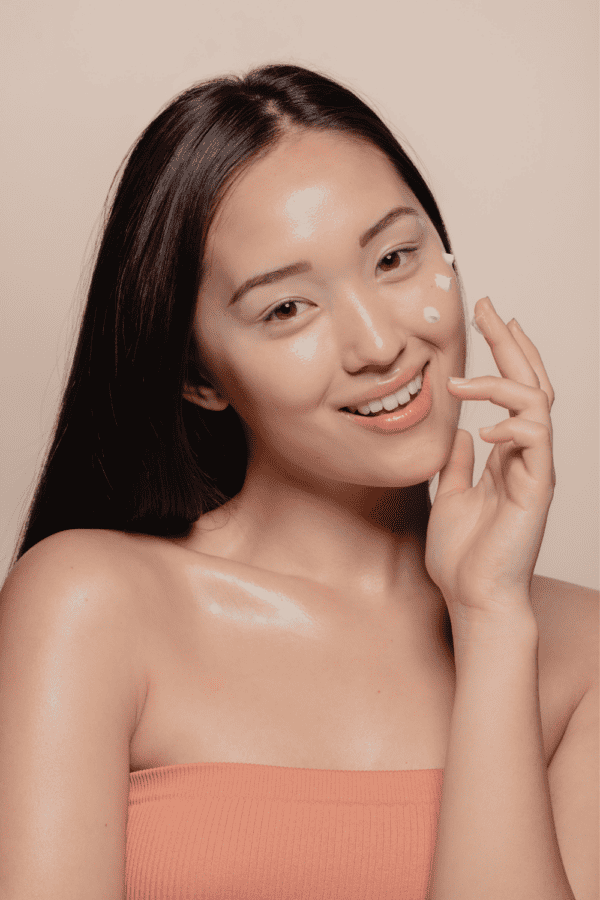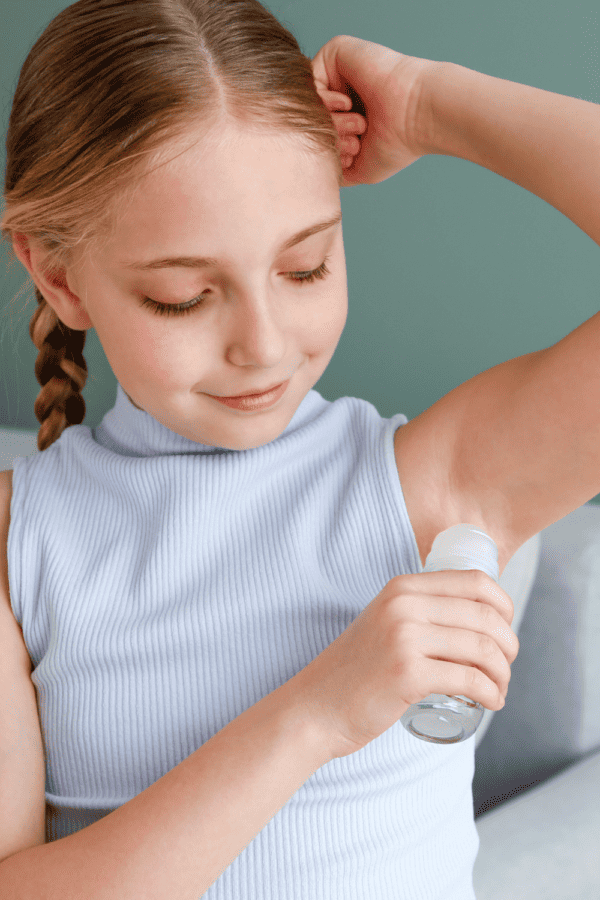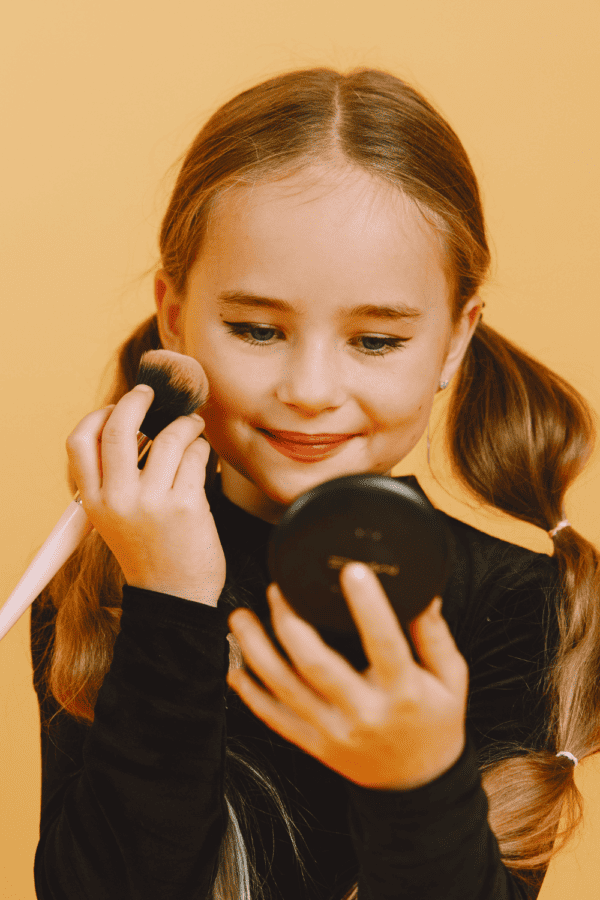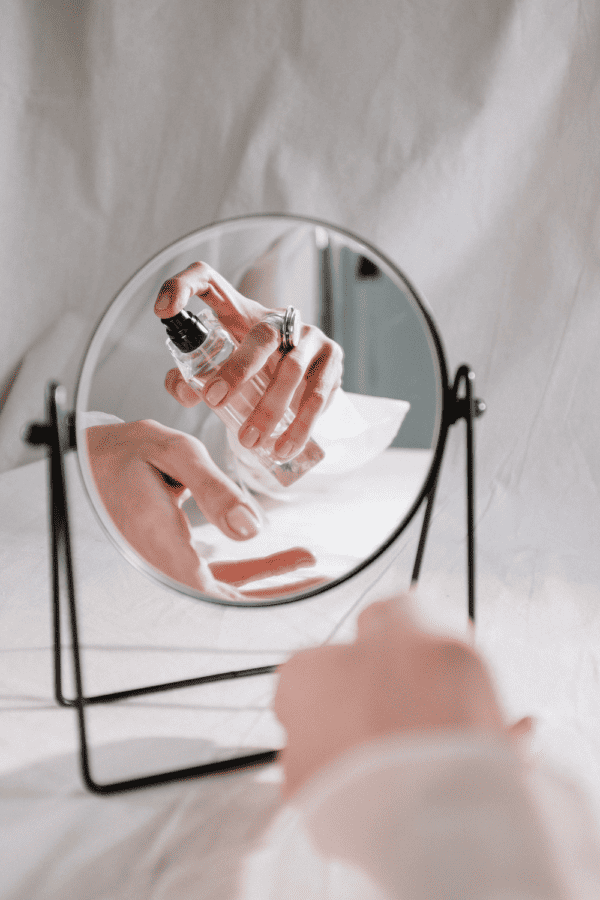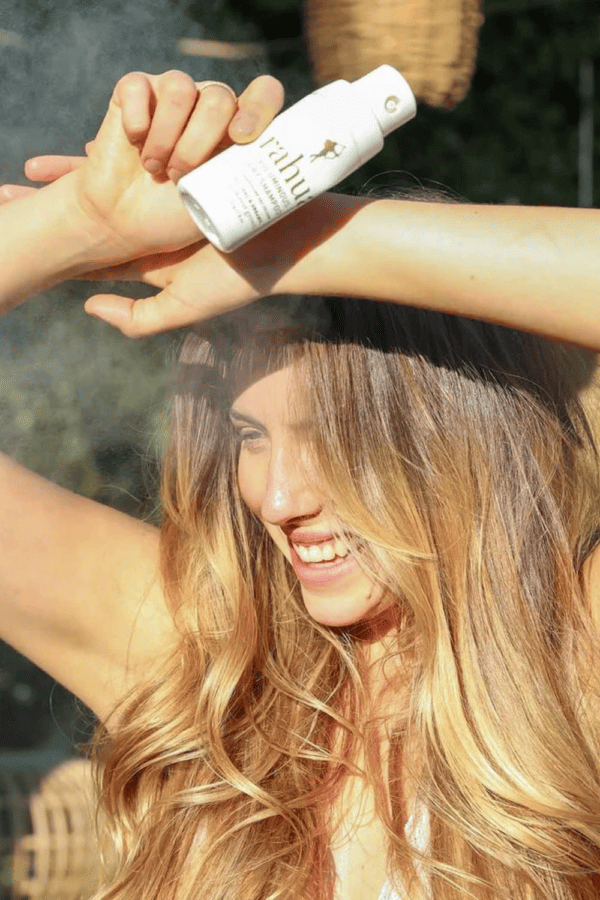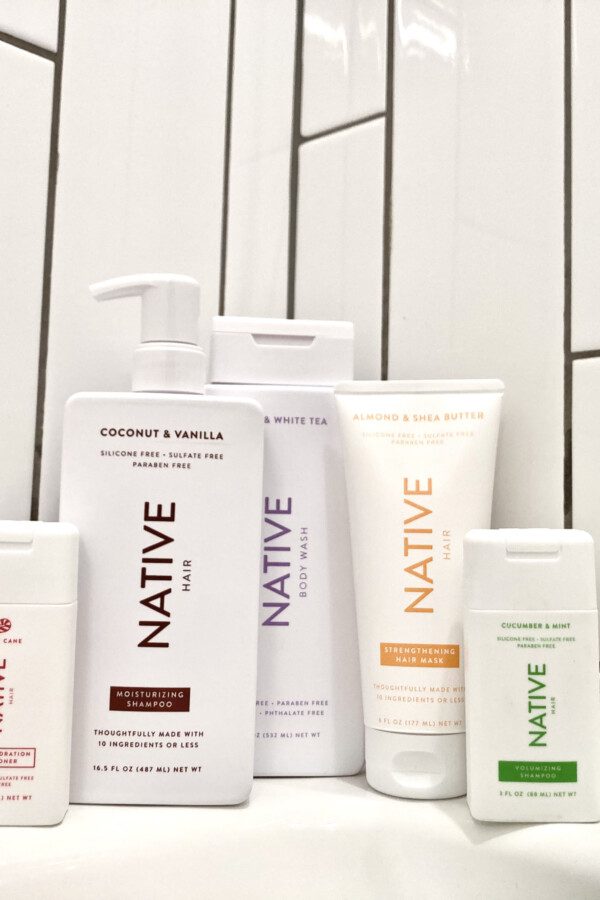The world of beauty is constantly evolving, and with the rise of social media and online communities, makeup has become more accessible to people of all ages. However, there are concerns about the ingredients used in traditional makeup products, especially for young children and teenagers. This has led to an increase in demand for non-toxic and organic makeup kits specifically designed for kids, tweens, and teens.
As you’ll see in a minute, U.S. law allows a lot of toxic endocrine disruptors, carcinogens, and allergens to get into our makeup products. This can be quite a problem for our kids, tweens, and teens who are in such an important time for their hormonal and overall development.
Adolescence is a great time to educate and empower your kids about how to choose safer cosmetics and personal care products. So in this article, I’m going to talk about the benefits of choosing non-toxic, natural, and organic makeup for kids, tweens, and teens. You’ll learn about the ingredients to be careful of, and which brands you can trust.
Table of Contents: Best Non-Toxic Makeup for Kids, Tweens, & Teens
- Why Choose Non-Toxic Kids Makeup?
- Toxic Chemicals To Avoid In Makeup for Tweens, Teens, and Kids
- Parabens
- PEGs & Other Ethoxylated Ingredients
- Fragrance
- Butylated Compounds
- FD&C Colors
- Mineral Oil
- Talc
- Lead
- The Best Non-Toxic, Natural, & Organic Makeup Kits for Kids & Tweens
- Best Clean Makeup Brands For Teenagers
- The Benefits Of Purchasing Safe Makeup For Kids
This post contains affiliate links, which means we may earn a small commission if you choose to make a purchase.
Why Choose Non-Toxic Kids Makeup?
In the United States, cosmetics are not regulated by the FDA the same way food and drugs are. As the Campaign for Safe Cosmetics states: “Cosmetics are one of the least regulated consumer products on the market today. The Federal Food, Drug and Cosmetics Act (FFDCA) includes 112 pages of standards for food and drugs, but just 2 pages are dedicated to cosmetic safety. Existing cosmetic safety law is over 75 years old and provides the FDA with virtually no statutory power to perform even the most rudimentary functions to ensure the safety of an estimated $71 billion cosmetic industry.”
For this reason, conventional makeup (including kids’ makeup kits specifically) contains a wide variety of toxic ingredients that can affect a person’s health—especially when used regularly over a long period of time.
In 2016, the Campaign for Safe Cosmetics and the Breast Cancer Fund did an investigation into what is actually in kids’ cosmetics products and Halloween face paint. Brands they tested included Disney, Lisa Frank, Claire’s, Hershey’s, and more.
I’m going to discuss some of the specific toxins they discovered in these products in a minute, but first, here is a quick summary of some of the things they found lurking in kids’ makeup and face paint products:
- Parabens: found in 34% of products tested
- Ethoxylated ingredients: found in 28% of products tested
- Fragrance: found in 50% of products tested
- BHT: found in 13% of products tested
- Mineral oil: found in 40% of products tested
- Talc: found in 18% of products tested
- Heavy metals: almost half of the products tested contained at least one heavy metal
As you can see, these toxins are quite common in kids’ makeup. Now let’s talk about why these ingredients are potentially problematic.
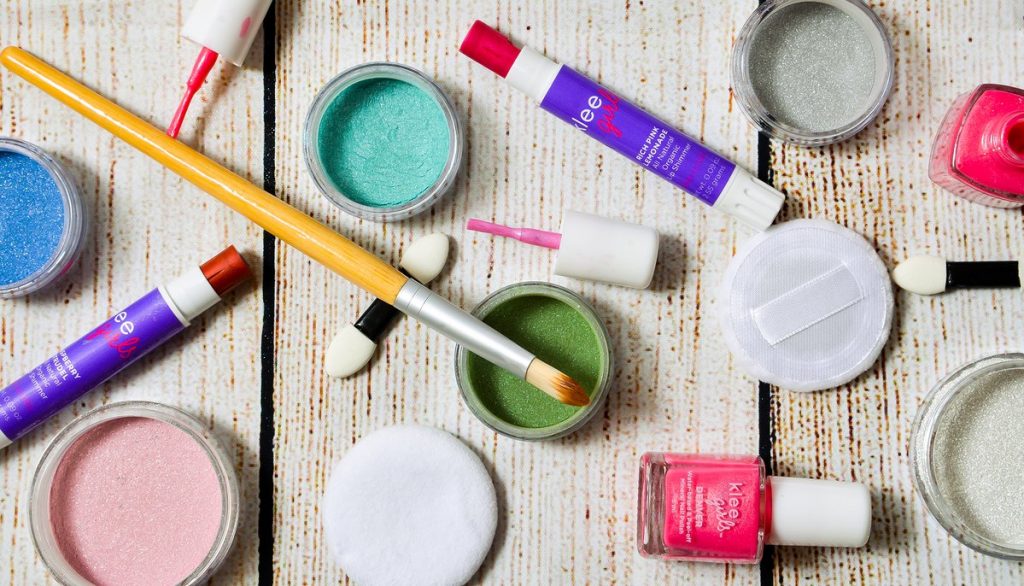
Toxic Chemicals To Avoid In Makeup for Tweens, Teens, and Kids
Parabens
This is a very common category of toxins that you’ll find in cosmetics and personal care products. Parabens are preservatives that help prevent the growth of things like mold and other microbes. Considering that mold can also be toxic, adding preservatives to personal care products and cosmetics doesn’t seem like a bad thing, right?!
But the problem is that parabens are linked to a host of serious health concerns, from cancer to infertility. They are known endocrine disruptors, which means they can harm the body’s many important hormonal systems. There are safer and more natural preservatives that can be used instead.
PEGs & Other Ethoxylated Ingredients
Polyethylene Glycol, also known as PEG, is commonly found in all kinds of products, such as lotions, toothpaste, and laundry products.
The problem with ethoxylated ingredients is not actually the ingredients themselves, but rather how they are processed. The process involves ethylene oxide and 1,4 dioxane. Ethylene dioxide is an irritant that’s known to cause multiple types of cancer and infertility. 1,4-dioxane is also carcinogen.
Unfortunately, products containing ethoxylated ingredients can be contaminated with both of these ingredients leftover from the manufacturing process. Because they are contaminants, however, you don’t see these two ingredients on the label.
Fragrance
We talk about “fragrance” on The Filtery all the time. In the United States, “fragrance” and “parfum” are protected by an “industry secret” law that allows companies NOT to disclose certain potentially toxic ingredients (there is a list of over 3,500 of them) on their labels, leaving consumers in the dark.
That list includes phthalates, which can disrupt the hormone function of your tween. It’s not just products like perfumes and candles that contain fragrance—a lot of cosmetics do as well.
Butylated Compounds
BHT and its relative, butylated hydroxyanisole (BHA), are synthetic antioxidants that are also commonly used in cosmetics to extend shelf life. BHA has been linked to reproductive and developmental toxicity, along with cancer.
Although more research still needs to be done on BHT specifically, it should also be noted that it’s a toluene-based ingredient. Toluene is a well-established toxin that can cause neurological damage and more. In the Campaign for Safe Cosmetics investigation, toluene was found in 11% of the products tested.
FD&C Colors
FD&C colors are synthetic dyes used in “food, drugs, and cosmetics” (which is what “FD&C” stands for).
This includes coal-tar dye, which can contain heavy metal contaminants (like lead). Coal-tar dyes will sneak into cosmetics and hair dyes through long and difficult-to-decipher names like P-phenylenediamine, diaminobenzene, and aminophenol.
These ingredients have been known to cause eye injury, allergic reactions, and several kinds of cancer. Coal-tar ingredients don’t have to be approved by the FDA.
Other FD&C colors have been associated with things like skin allergies and hyperactivity in children.
Mineral Oil
It might sound like a “safe” and “natural” ingredient, but mineral oil is actually derived from crude oil, a.k.a. petroleum. It can contain a significant amount of polycyclic aromatic carbons (PAHs), which are classified as carcinogens.
Talc
In its pure form, talc is safe. The problem is that talc is often contaminated with asbestos, which causes cancer, so it’s a risky ingredient to use.
Lead
Lead contamination is a real problem, especially in lipsticks and lip glosses. You can read more about that here. Because even small amounts of lead can negatively affect children, and since it’s much more likely that lip products will be ingested, it’s best to be extra careful to use lead-free lipsticks, balms, and glosses.
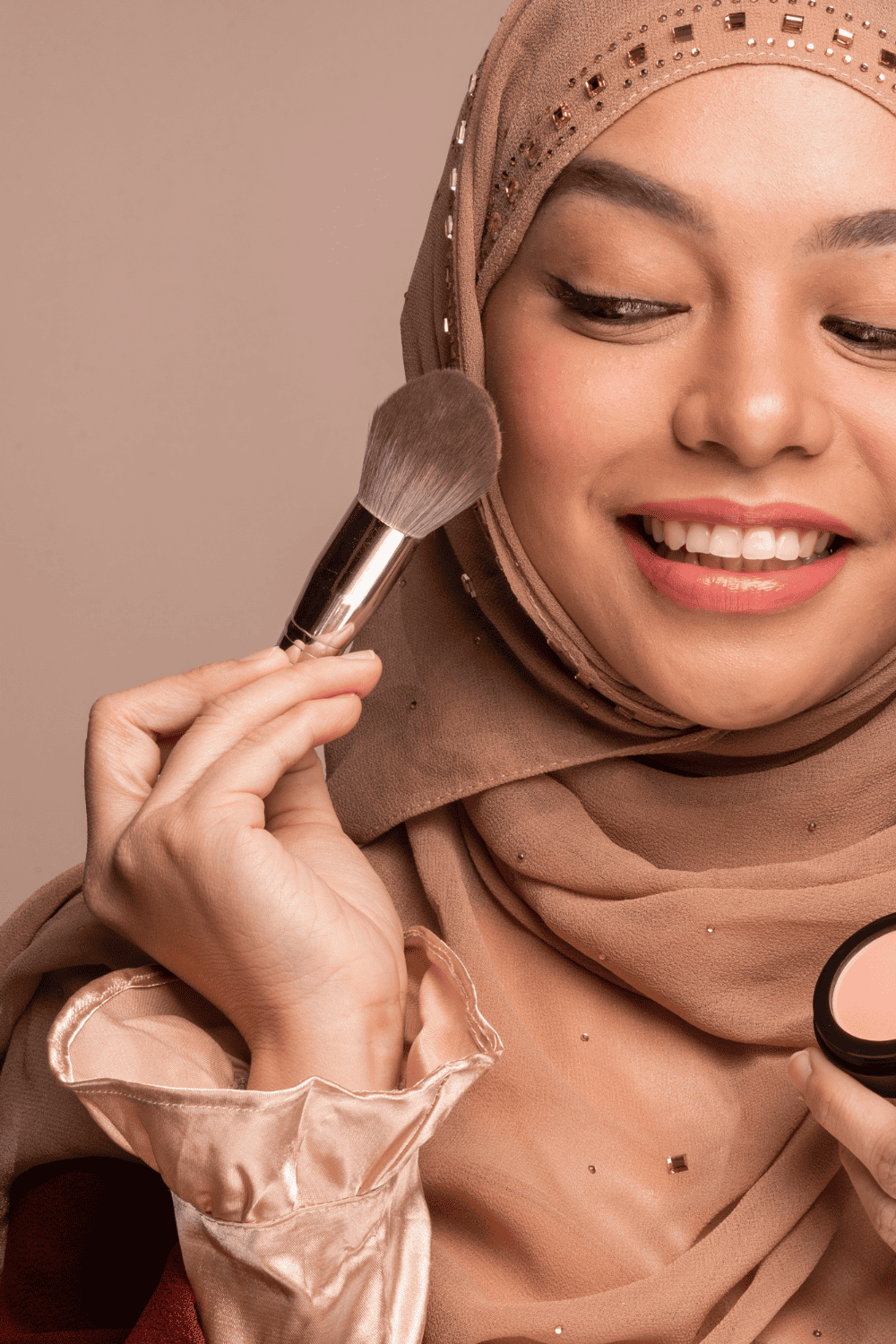
The Best Non-Toxic, Natural, & Organic Makeup Kits for Kids & Tweens
Below are my suggestions for the best non-toxic, natural, and organic kids’ makeup kits. It’s important to note that there actually are not any kids’ makeup kits that are 100% organic. The recommended brands below DO use all non-toxic and natural ingredients, with some organic ingredients. This is partly because not all ingredients can even be certified organic. (For example, natural minerals mined from the earth cannot be certified organic.)
The following brands are great for kids ages 9 to 12-ish. I’ll dive into each one, but my recommendations for makeup that’s safe for kids and tweens include Klee Naturals, Evereden, Prim & Pure, Jovy, and Urban Kangaroo.
Below that are some additional brands that offer good options when it comes to makeup for teens.
Klee Naturals
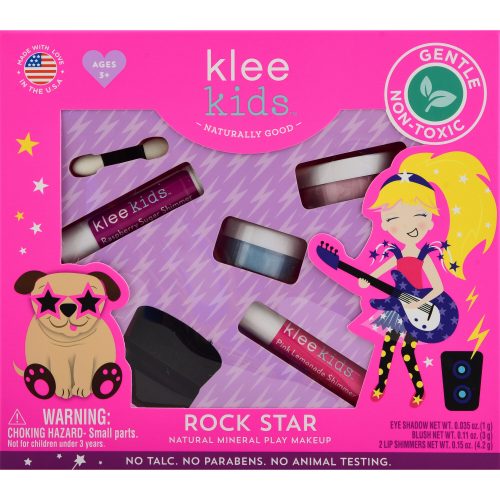
Klee Naturals is a great brand for non-toxic makeup sets for kids and tweens. They have a lot of different options—whether your tween is into tea parties or rainbow fairies.
Klee Naturals mostly-natural kids makeup uses ingredients like beeswax, shea butter, and natural minerals for their play makeup. They use absolutely no talc, parabens, phthalates, FD&C colors or dyes, or gluten.
In addition to their lip glosses, eyeshadows, and other kids’ makeup, Klee Naturals also carries water-based nail polish, hair, and body care for kids and tweens as well. Plus, everything is made in the USA, and each purchase supports a local charity.
Evereden
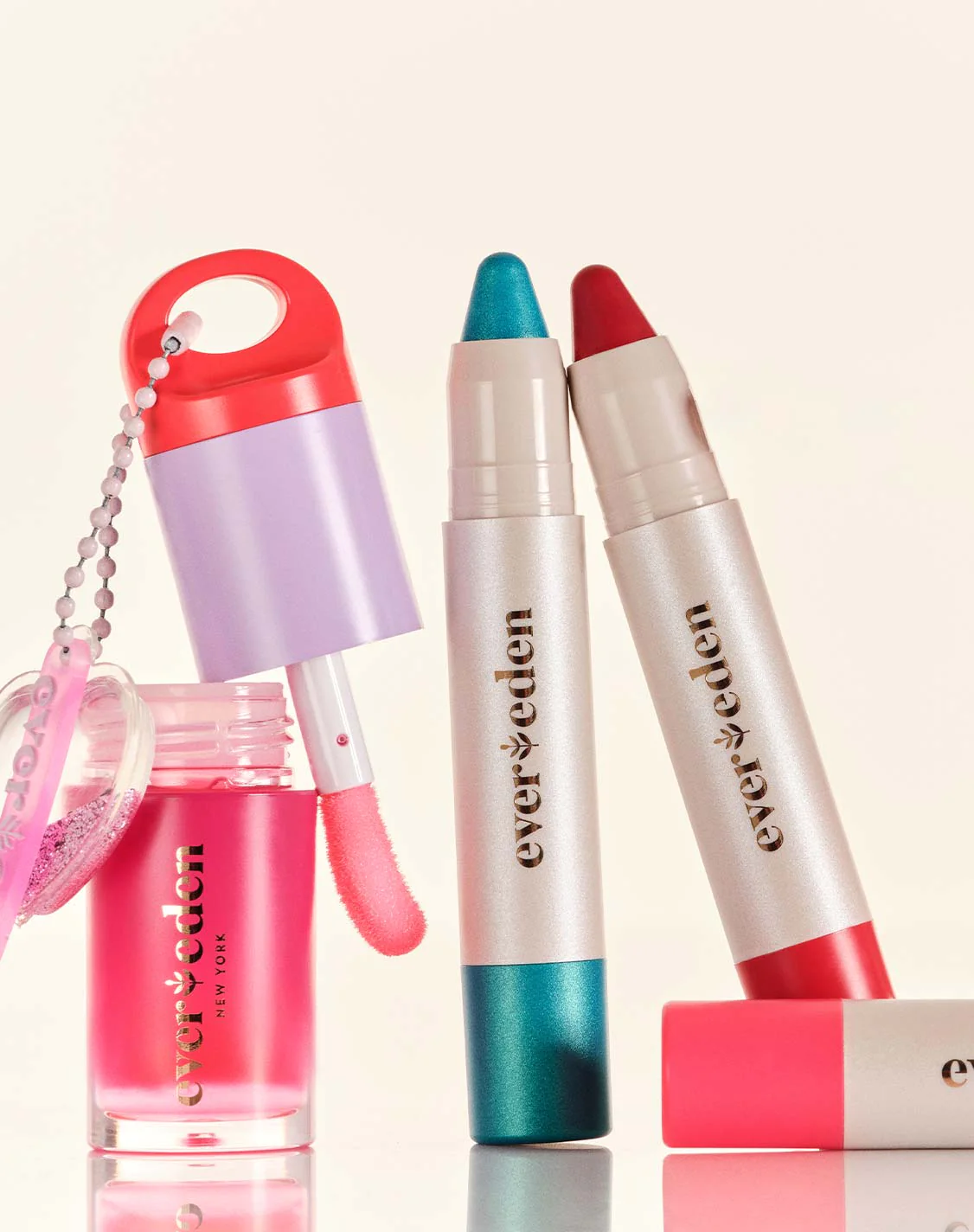
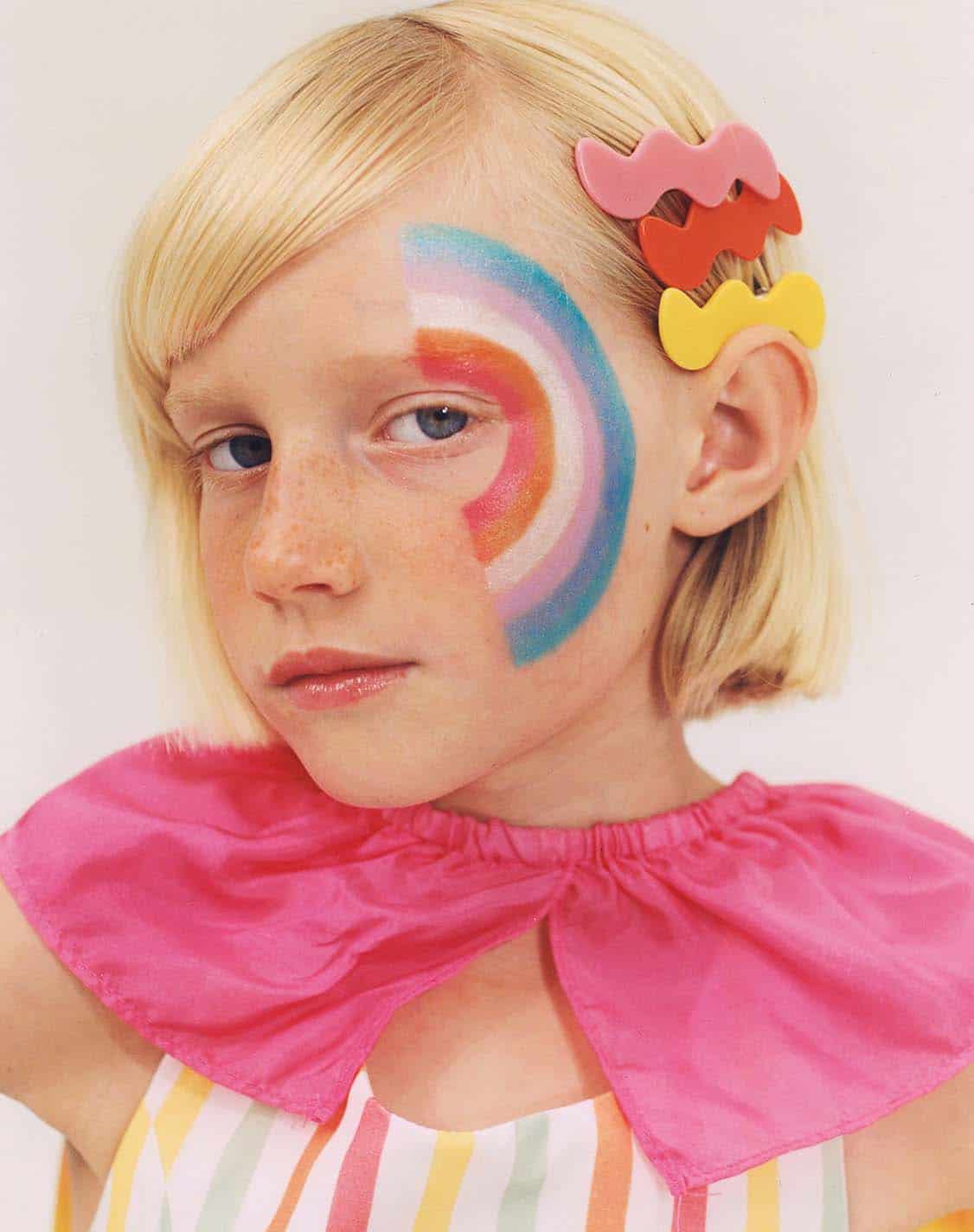
Evereden is an excellent skincare and personal care brand for moms and kids, and now they have kids play makeup, too!
They offer a “rainbow” of multi-use face crayons that come in nine different fun colors. They can be used on the lips, eyes, and anywhere on the face, and are formulated for kids aged 3 and up.
Evereden’s vegan kids makeup is also gluten-free and made from mostly natural ingredients. They don’t use toxicants like parabens or phthalates in their products.
While Evereden’s safe kids’ makeup isn’t EWG Verified yet (some of their other products are), they provide the EWG score for each ingredient right on the product page, making it easier for parents to check for anything questionable. As you can see, none of the ingredients in their Play Crayons score above a 3 (which is good!).
They also offer gift sets, lip gloss, kids’ face wash and face cream, and more.
Prim & Pure
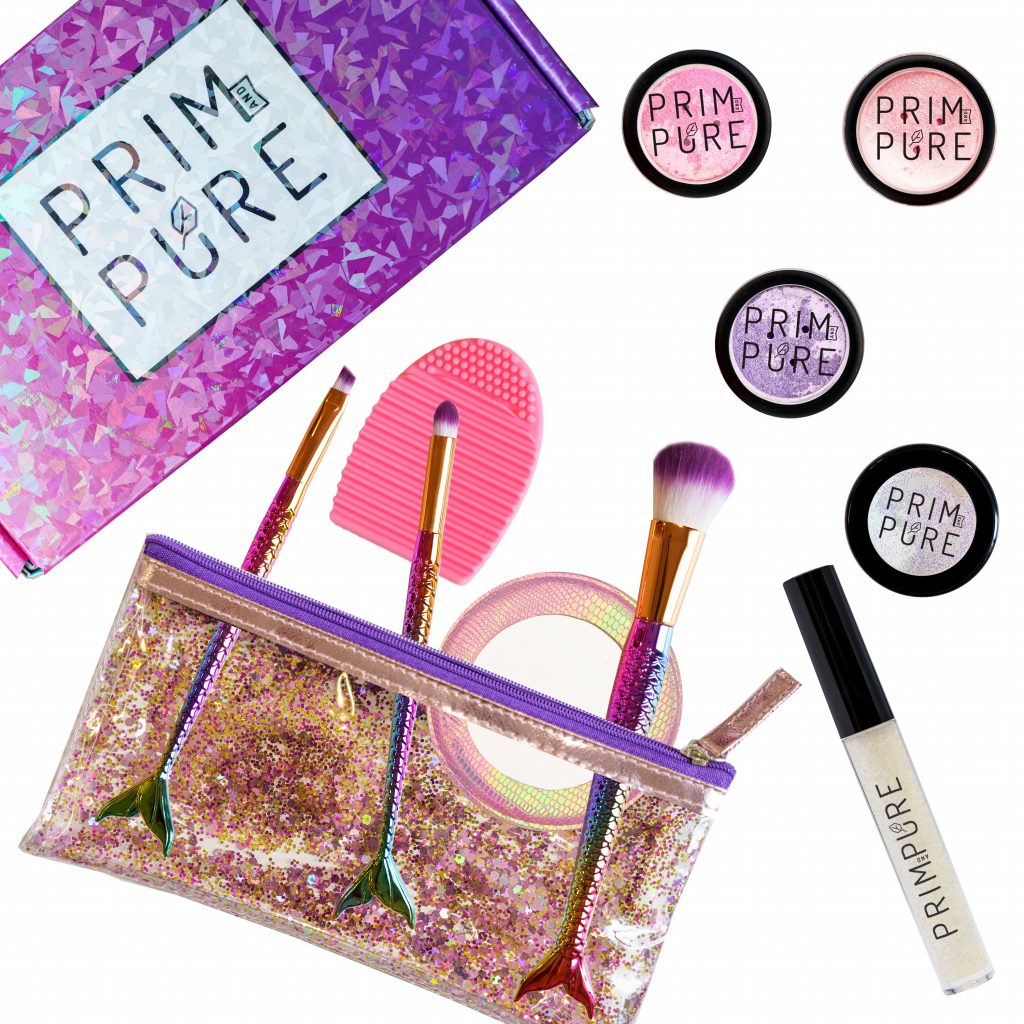
Prim & Pure carries really fun eye shadow palettes, blushes, lip gloss and balms, nail polishes, nail stickers, biodegradable body glitter, and more. They have all kinds of different gift sets and accessories, too.
All of their products are made with natural, non-toxic ingredients that are free from parabens, phthalates, GMOs, synthetic FD&C dyes, gluten, and animal testing. They also use many USDA certified organic ingredients, which are indicated with an *asterisk.
Everything is made in the USA, and each purchase gives back to non-profit organizations that support children.
Prim & Pure also has a moms and teens collection now too!
Jovy
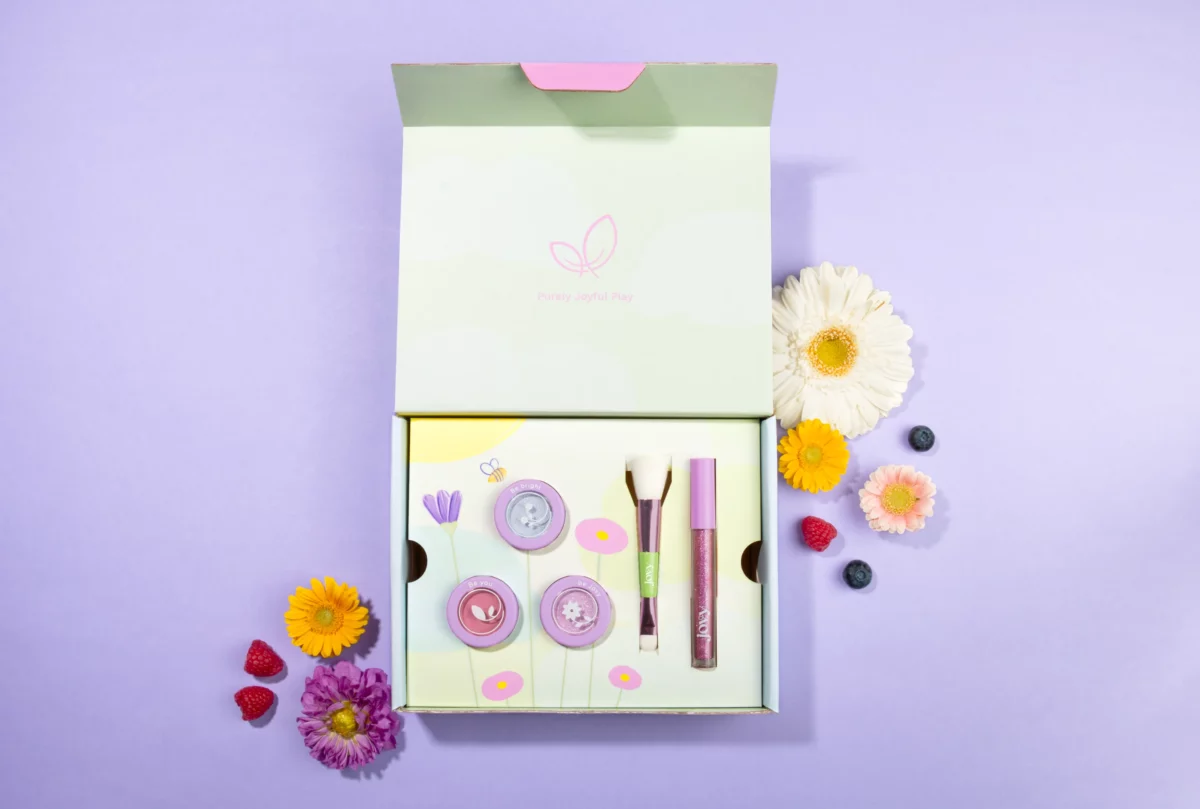
Jovy is a new non-toxic makeup brand for kids. Not only do they use clean, plant-based ingredients, but they’re also totally vegan, cruelty-free, and nut-free. (They’ve recently obtained their EWG Verified badge too, so be on the lookout for that on their website and packaging soon!)
Everything is free from phthalates, parabens, petrochemicals, artificial dyes and fragrances, and talc. They do use natural “aromas” (aka fragrances), but they list out the specific fragrance ingredients used right next to their main ingredient list. (Points for true transparency!)
They offer a kids’ makeup kit that comes with gloss and multi-purpose pressed powders, and then they also have fun skin stencils, which kids can put on their faces, arms, hands, etc!
Urban Kangaroo
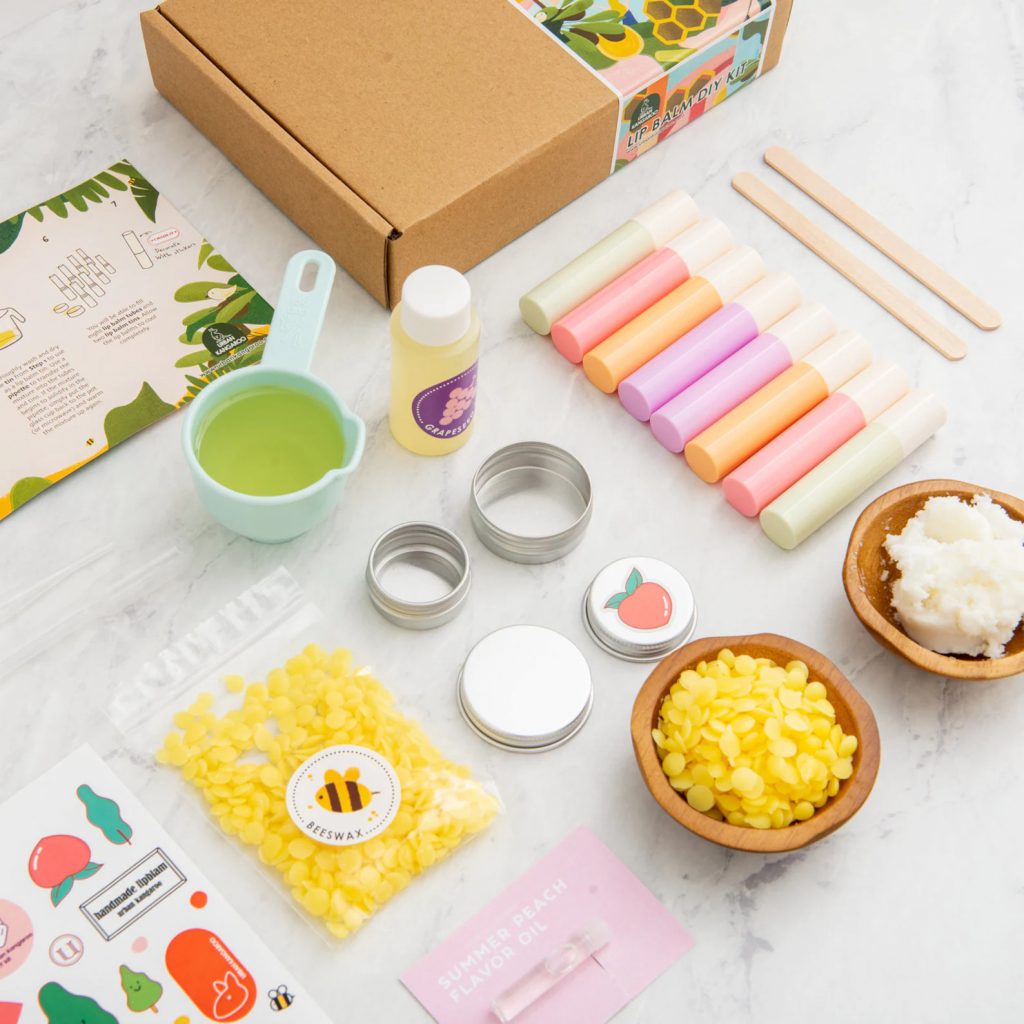
You could always try making your own natural makeup for kids if that’s your thing!
This DIY lip balm-making kit would be a fun afternoon activity with your child. The minimal natural ingredients are made and sourced ethically in the USA.
Best Clean Makeup Brands For Teenagers
My recommendations for the best makeup for tweens and teenagers include 100% Pure, Honest, and Fat and the Moon. These brands are good options for teens, ages 13 to 19. Of course, they can technically be used by adults, but they are great for teens as well because they carry colorful cosmetics with fun and unique branding while prioritizing natural, organic, and wildcrafted ingredients.
100% Pure
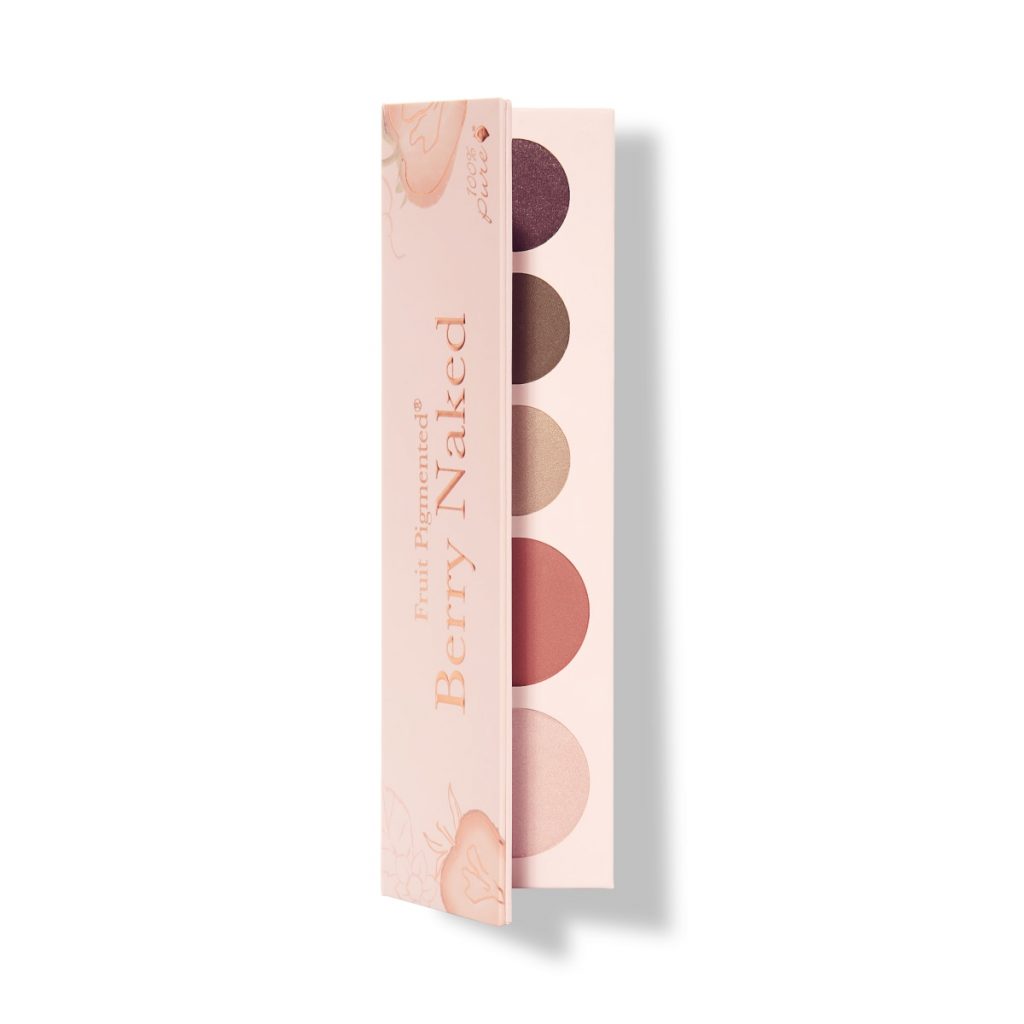
100% Pure carries a really wide variety of fruit-pigmented makeup, from eyeshadow palettes to lipsticks, lip glosses, and more. Instead of synthetic dyes, this vegan-friendly and certified cruelty-free brand uses fruit extracts like cherry, pomegranate, and rose petals.
Many of their ingredients are organic, and almost everything is made in the USA.
Honest
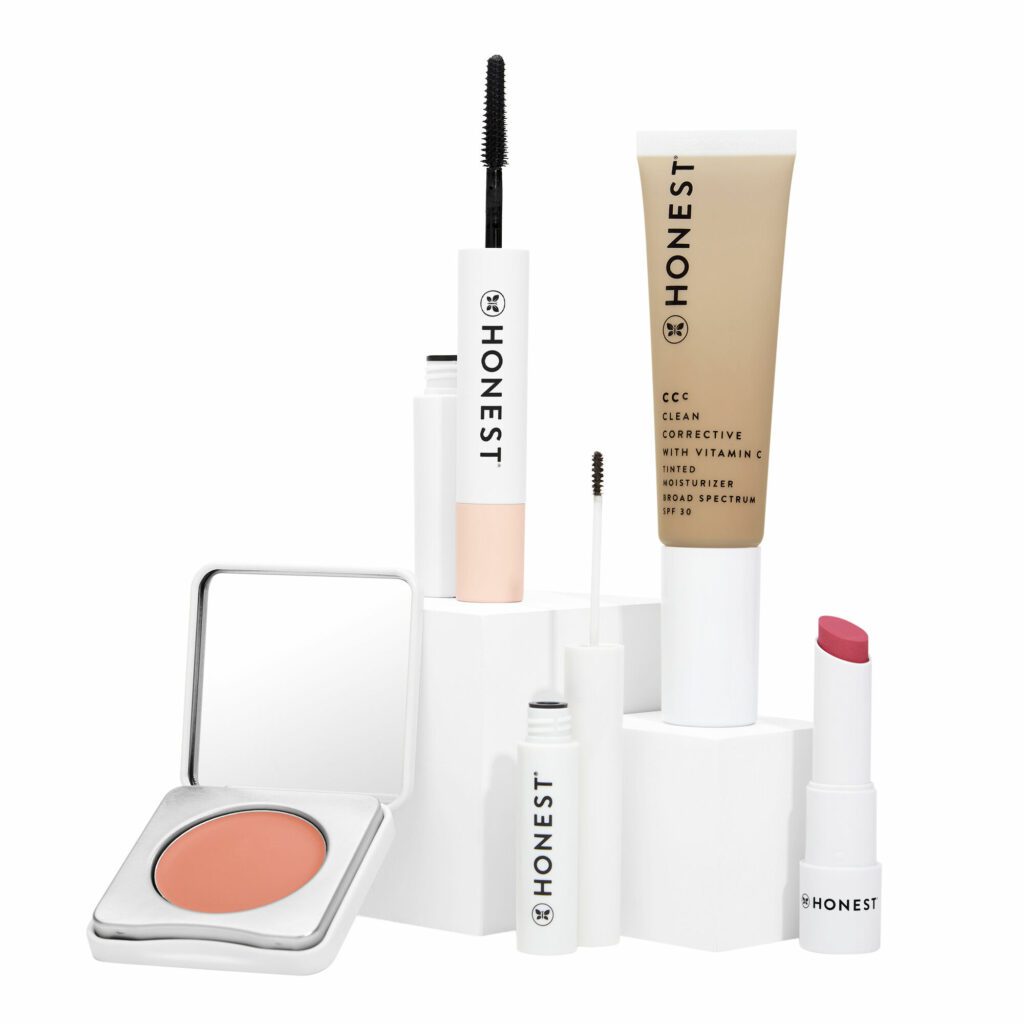
Honest is another great clean makeup brand for teens because their products are affordable and easy to use. They have many bright colors for eyes and lips, but they also have more subtle makeup options, like their No Makeup Makeup Kit. This kit would be a good option for young people who are just getting into the makeup game and want some light coverup, mascara, and a little pop of color—nothing drastic.
You can check out my full review of Honest Beauty here.
Fat And The Moon
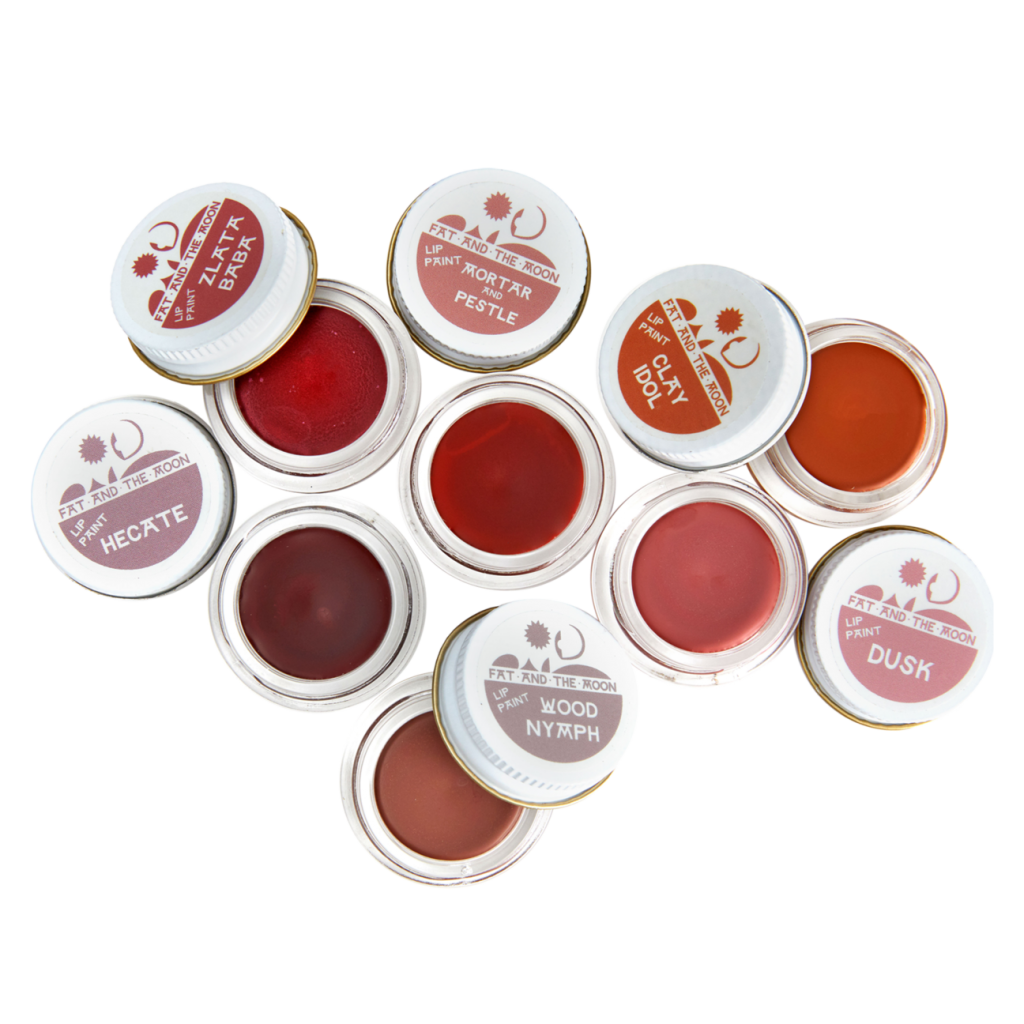
Founder and herbalist, Rachel Budde, has built Fat And The Moon around providing handcrafted, herbal body care products using age-old ingredients and earth-centered recipes that have been passed down from various healing traditions for generations.
Their “Adornment” natural makeup kits include lip paint, eye coal, cheek stain, highlighters, and more (many of which can be used as multipurpose products). While not technically “tween makeup,” these kits are great for people of all ages!
Everything is handcrafted to order in the USA, and many of the ingredients are organic.
Containers For Storing Tweens’ & Teens’ Makeup And Brushes
Many of the above makeup kits come with carrying cases, but if you’re looking for extra storage, Made Trade, BLK+GRN, Annemarie, ES Essentials Home Decor, and IKEA carry some great plastic-free cosmetics cases and storage units in a variety of shapes and sizes that are great to keep at home or take on the go.
The Benefits Of Purchasing Safe Makeup For Kids
Not only will choosing a non-toxic makeup kit for your tween give you more control over what sorts of ingredients are absorbed into their skin, but it can also have some other benefits as well, like:
Keeping Them From Sharing Others’ Not-So-Desirable Makeup
It can be a lot of fun for kids and teens to do makeovers with their friends. If your kids have their own natural and non-toxic makeup set, it can help reduce the exposure they get from their friends’ makeup products.
Providing an Opportunity for Ingredient Education and Awareness
As you know, it can be overwhelming at times to learn about all the different toxic ingredients and materials we’re surrounded by every day. It can feel like swimming upstream.
One of the best ways to turn that overwhelm into empowerment is to learn and implement, little by little, the way you learn a new language. And just like learning a language, it’s so much easier to pick up when it’s ingrained in one’s culture and environment, especially as a young person.
When children and teenagers slowly learn which ingredients to watch out for and avoid, it can be less overwhelming and more empowering in the long run because these habits are normal.
The good news is that it actually doesn’t take long to make a difference either. A 2016 study called the HERMOSA Intervention Study, which followed 100 adolescent Latina girls, found that after just three days of avoiding personal care products that contained endocrine-disrupting chemicals such as phthalates and parabens lowered the concentrations of most of these chemicals in their urine.
This suggests that choosing personal care products and cosmetics carefully can potentially make a significant difference in how many toxic chemicals are coursing through adolescents’ bodies.
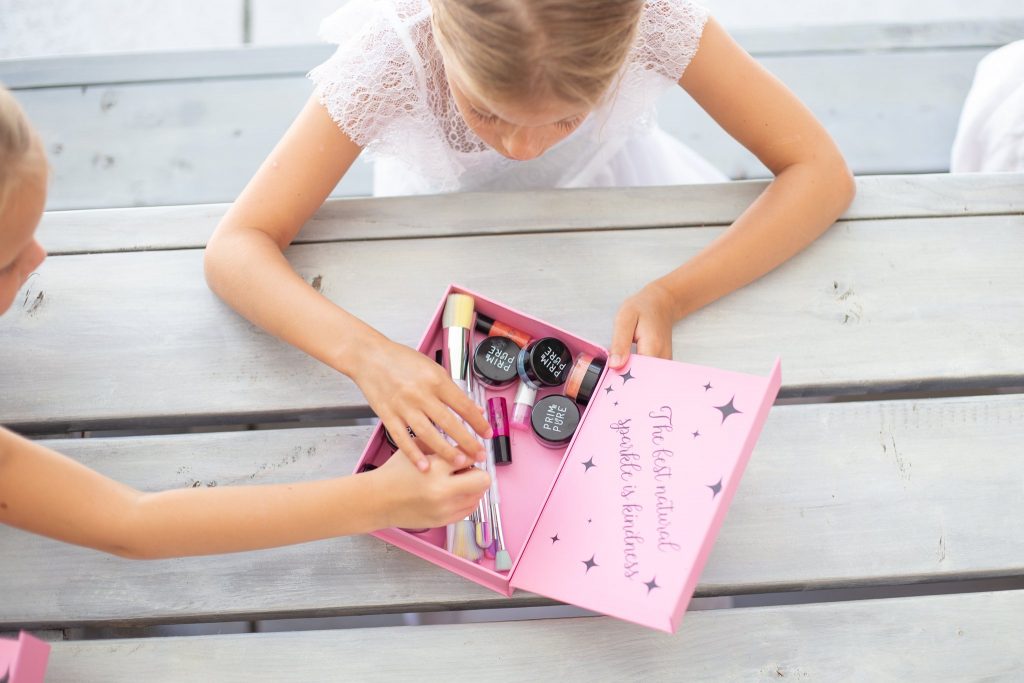
Encouraging Self-Care and Mindfulness Habits Early
We know that the cosmetics industry is certainly guilty of exacerbating unhealthy beauty standards for women and girls by communicating that they’re not “pretty enough” without their faces caked in colors. This is definitely something to be aware of when deciding when to let your kids start using makeup and how much.
But kids’ makeup can also be a means of empowerment, play, and an opportunity for a mindfulness ritual. After all, humans all over the world have been painting color onto their faces basically since humans have existed—for self-expression, for protection, for communication, and more.
Establishing A Skincare Cleansing Routine
Establishing a healthy skincare routine is always a good idea, especially considering that many teens struggle with acne. When tweens start using makeup, it can be a great opportunity to talk about why removing makeup before bed is important, how to cleanse and moisturize your face properly, and how to care for pimples.
We actually have an entire article on the best non-toxic, natural, and organic skincare brands for young people—check it out here!
(Oh, and check out these organic and plastic-free hair ties and scrunchies to hold their hair back while they wash their face!)
Promoting Hygiene And Proper Care Of Cosmetic Instruments
Keeping one’s skin clean means also keeping one’s makeup brushes and tools clean and cared for.
This eco-friendly makeup brush set from Honey Bee Gardens is a great starter set for tweens and teens. It comes with five different brushes made with bamboo handles and a hemp & cotton carrying case. It’s super affordable, too. EcoTools also carries a really wide variety of brushes, sponges, and other eco-friendly makeup tools and accessories.
Dermatologists recommend cleaning makeup brushes and tools at least once a month in order to keep bacteria and extra oils at bay. You don’t really need anything fancy to clean your brushes; a simple non-toxic dish soap with a cloth towel will work just fine.
Or if you want something that will disinfect easily (you don’t even have to wipe or rinse it off), Force of Nature’s all-purpose cleaning spray is also great for makeup brushes.
Transitioning to wearing makeup is one of those rights of passage that makes us wonder how the time flew by. Getting your tween or teen natural, non-toxic, organic makeup opens the door to a slew of opportunities to educate on proper personal hygiene and the pitfalls of toxic ingredients. The standards and habits you demonstrate now will benefit your child for years to come.
To get more non-toxic lifestyle tips, info about toxins in the news, and exclusive content delivered to your inbox once a week, sign up for Filtered Fridays.

